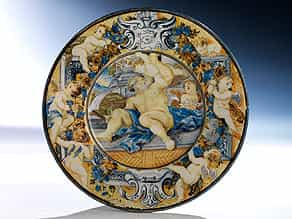Votre recherche majolika dans la vente
Majolique
jeudi, 27 juin 2013
» reset
Votre assistant d‘art personnel

Voulez-vous acheter un objet similaire?
Nous vous informons volontiers si des objets similaire vendus dans une de nos prochaines vente aux enchères.
Veuillez accepter notre politique des confidentialité
588
Majolika-Teller aus der Werkstatt des Carlantonio Grue (1655 Castelli - 1723)
Durchmesser: 24 cm.
Castelli, Anfang 18. Jahrhundert.
Prix de catalogue € 22.000 - 25.000
Prix de catalogue€ 22.000 - 25.000
$ 23,760 - 27,000
£ 19,800 - 22,500
元 172,040 - 195,500
₽ 2,188,780 - 2,487,250
Teller mit breiter Fahne. Die Fahne zieren ein illusionistischer Rahmen, umwunden von Festons, in welchen Putti sitzen. Die Putti in der Fahne wenden sich erschrocken ab, nur einer blickt zur Szene. Der Spiegel zeigt Saturn, der sein Kind verschlingt und ein Putto mit Schriftband "FAME" (ital. Hunger oder Gier). Die Bemalung in Blau, Schwarz, Gelb, Grün und Orange. Bruchrest.
Anmerkung I:
Die literarische Grundlage liefert Hesiod. Saturn wird prophezeit, dass er durch seine Kinder entmachtet werden wird. Daraufhin frisst er sie auf, bis auf einen - Jupiter - der von seiner Frau versteckt wird. Jupiter entmachtet ihn und Saturn flieht nach Latium, wo er den Menschen den Ackerbau beibringt.
Anmerkung II:
Die Verkürzung und Untersicht, in der Saturn zu sehen ist, lässt darauf schließen, dass ein Deckengemälde als Vorlage diente. Pietro da Cortona stellte Chronos, seine Kinder verschlingend, im Palazzo Barberini, Rom, in sehr ähnlicher Weise dar. Es ist zu vermuten, dass nach dem Deckenfresko ein Stich angefertigt wurde, nach dem Carlantonio Grue arbeitete. Eine Zeichung mit einer ähnlichen Darstellung von Samuel Bottschild hat sich in der Staatlichen Kunstsammlung in Dresden erhalten.
Literatur:
Ein Teller von Carlantonio Grue mit einer vergleichbaren Rahmen-Gestaltung im Museum von Cluny, vgl. Jeanne Giacomotti, "Catalogue des majoliques des musées nationaux", Paris, 1974, S. 473, Abb. 1392. (9300047)
Maiolica dish from the workshop of Carlantonio Grue (1655 Castelli - 1723)
Diameter: 24 cm.
Castelli, beginning of the 18th century.
Dish with broad border. The border is decorated with festoons wrapped around a trompe l'oeil frame. In between the festoons are seated putti, all but one of whom averting their eyes in shock from the painted scene at the centre. The centre depicts the mythological scene of Saturn devouring his child and a putto holding a scroll that reads FAME (Italian: hunger or greed). Painted in blue, black, yellow, green and orange. Restored cracks.
Notes I:
Hesiod records this mythical scene. According to prophecy, Saturn was to be overthrown by his children, whereupon he would devour them all, apart from Jupiter who is hidden by his wife. Jupiter later overthrows his father. Saturn flees to Latium, where he teaches the people how to cultivate the earth.
Notes II:
The foreshortening and view of Saturn from below suggests that a ceiling fresco served as a model for this painting. Pietro da Cortona painted Chronos devouring his children in the Palazzo Barberini in Rome in a very similar manner. It can be assumed that the ceiling fresco was copied as an engraving, which served Carlantonio Grue as a model for his painting. A drawing with a similar illustration by Samuel Bottschild can be found in the collection of the Staatlichen Kunstsammlung in Dresden.
Literature:
For a dish by Carlantonio Grue with a similar frame design at the Museum of Cluny, see Jeanne Giacomotti, Catalogue des majoliques des musées nationaux, Paris, 1974, p. 473, plate 1392.
This object has been individually compared to the information in the Art Loss Register data bank and is not registered there as stolen or missing.
Votre assistant d‘art personnel
Vous voulez être informé quand dans nos prochaines ventes aux enchères une œuvre d‘art similaire sera proposée? Veuillez activer votre assistant d‘art personnel.
Veuillez accepter notre politique des confidentialité
Voulez-vous acheter un objet similaire?
Voulez-vous acheter un objet similaire? Acheter en vente privée dates de vente aux enchères
Nos experts vous aident personnellement dans votre recherche d‘objets d‘art.
Voulez-vous vendre une œuvre similaire?
Livrez maintenant Vente privée FAQ
Vos envois sont toujours les bienvenus. Nos experts se feront un plaisir de vous conseiller personnellement, nous nous réjouissons de votre appel.
Contactez nos experts
further catalogues Meubles | Tableaux du XVI - XVIII siècle | Porcelaine, argenterie, cristal de roche | Bibliothèque | Sculptures et Haute époque | Ceramique | Majolique | Hampel Living | Tableaux du XIX - XX siècle | Art russe | Art moderne | Art d'Asie, Bijoux & Montres | Livres, dessins et gravures | Art populaire et Divers


















